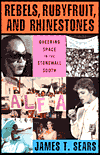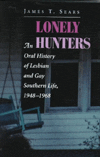
 The Independent Gay Writer newsletter is proud to
welcome Gene Hayworth as a new reviewer. He will be handling mainly
non-fiction works in the months to come and the more literary
offerings.
The Independent Gay Writer newsletter is proud to
welcome Gene Hayworth as a new reviewer. He will be handling mainly
non-fiction works in the months to come and the more literary
offerings. He begins with a review of James T. Sears' Rebels, Rubyfruit, and Rhinestones: Queering Space in the Stonewall South. Rutgers University Press. ISBN 0-8135-2964-6. 2001. 420 p.
| Rebels,
Rubyfruit, and Rhinestones: Queering Space in the Stonewall South by James T. Sears Rutgers University Press ISBN 0-8135-2964-6. 2001 420 p. Casual readers of recent news stories about same-sex marriage may be led to draw many uninformed conclusions from the headlines. The media reports have emphasized conflicts such as the division between individual clergy members who agree to solemnize same-sex unions and church officials who refuse to recognize such sanctions, or court clerks who issue marriage licenses and local politicians who condemn those actions. Around the country gay and lesbian couples are stepping up to the altar to participate in ceremonies that celebrate their unions. Officials in a few states such as Oregon indicate that a ban on gay marriage probably violates state constitutions. In general, these headlines give the impression that interest in same-sex ceremonies is a recent phenomenon. Yet these controversies are not new.  Those with an interest in such gay and
lesbian issues may wish to read James T. Sears' recent study, Rebels, Rubyfruit, and Rhinestones:
Queering Space in the Stonewall South. Historically, Sears
notes, requests for same-sex marriage licenses started as early as
July, 1970, when Tracy Knight and her partner Marjorie Ruth Jones
requested a license from the Clerk’s Office in Jefferson County,
Kentucky. Sears, a professor at the University of South Carolina, helps
dispel such current misconceptions by exploring the complicated fabric
of gay and lesbian lives and the diversity that is inherent in our
communities. Rebels, Rubyfruit, and
Rhinestones is the second volume in what Sears describes as "a
multivolume work telling the stories of queer southern life through
characters who shaped and were shaped by the events following the
tsunami of Stonewall." The first volume, The Lonely Hunters : An Oral History of
Lesbian and Gay Southern Life, 1948-1968, received critical
acclaim. Those with an interest in such gay and
lesbian issues may wish to read James T. Sears' recent study, Rebels, Rubyfruit, and Rhinestones:
Queering Space in the Stonewall South. Historically, Sears
notes, requests for same-sex marriage licenses started as early as
July, 1970, when Tracy Knight and her partner Marjorie Ruth Jones
requested a license from the Clerk’s Office in Jefferson County,
Kentucky. Sears, a professor at the University of South Carolina, helps
dispel such current misconceptions by exploring the complicated fabric
of gay and lesbian lives and the diversity that is inherent in our
communities. Rebels, Rubyfruit, and
Rhinestones is the second volume in what Sears describes as "a
multivolume work telling the stories of queer southern life through
characters who shaped and were shaped by the events following the
tsunami of Stonewall." The first volume, The Lonely Hunters : An Oral History of
Lesbian and Gay Southern Life, 1948-1968, received critical
acclaim.In Rebels, Rubyfruit, and Rhinestones: Queering Space in the Stonewall South, Sears has selected a representative cross section of men and women active in several civil rights movements that have influenced our lives: drag queens, political activists, feminists, ministers, students, socialists, and conservative business leaders are just a few examples. Sears’ book is especially enlightening in its emphasis on how slowly laws effecting gays and lesbians have changed, from regulations that made it illegal to serve drinks to “known homosexuals,” to the cross-dressing ordinances used to arrest suspected homosexuals. This important work explores the history of the many homosexual organizations that developed in the sixties and seventies, and provides a detailed account of important publications from the Lavender Wave to the Gay Times. Those interested in political activism will appreciate Sears’ balanced treatment of individuals with conservative as well as radical perspectives. He examines the growth of local groups such as the Charlotte Gay Alliance for Freedom and the Pink Triangle Alliance formed in New Orleans, and considers their impact in the larger context of national groups such as the Gay Activist Alliance, the Mattachine Society, and the Daughters of Bilitis. Worth special mention is the history of the organization of the North American Conference of Homophile Organizations (NACHO) which held its first meeting in 1964. Although the focus of Sears’ study is the South, it is impossible to write about gay and lesbian history without acknowledging the fact that there was no true geographical center for what began as the Homophile Movement. The people Sears discusses represent a broad spectrum of the U.S., from California to New York, from Canada to New Orleans. Sears’ history covers the first two decades of the Homophile movement, beginning in 1951, and illustrates some of the complex issues that have inhibited any unified grassroots movement. Sears describes poignant events in gay and lesbian history such as the 1973 fire at New Orleans' Upstairs Lounge in which 32 people died, and significant turning points like the organized marches against Anita Bryant. Picketing, riots, anger and passion make up our history. If our movements have been marred by violence, there have also been an equal number of reasons for joy and celebration, and Sears provides ample illustrations. Those who are unfamiliar with our history might conclude that gays and lesbians stand united against individuals who wish to limit marriage to one man and one woman. It is important to recognize that not every homosexual couple has a desire to participate in such ceremonies. For some of us, pride in our sexuality provides a reason to rebel against those traditional, heterosexual values that marriage represents. There are rebels on all sides, and Sears’ book openly illustrates that diversity. Those who fear we will “indoctrinate” their children do not realize that we do not have one doctrine. But for all of us it is a matter of Civil Rights. Banning same-sex unions is equivalent to denying women the right to wear pants, or arresting a bartender for serving a gay man a drink. Rebels, Rubyfruit, and Rhinestones is extensively researched, providing a detailed account of many individuals who shaped gay and lesbian culture, and it is highly recommended. |
Gene Hayworth Bio Gene Hayworth grew up in North Carolina and attended undergraduate school at UNC - Greensboro. He worked for 10 years as a layout artist, technical writer, computer specialist and training instructor before returning to school at the University of Rochester, where he received a Masters degree in English with a concentration in creative writing, and an MLS from Syracuse University. He moved to Colorado in 1995 and worked at CARL Corporation for several years, and in the summer of 1999 he worked for CARL in Singapore, which resulted in the publication of an article about his experiences titled "Singapore Libraries Usher in a New Era," in Computers in Libraries, 20:6 (Nov./Dec. 2000). He is an avid reader and has written several book reviews for Colorado Libraries. In February 2003 he prepared an exhibit at the Fales Library, NYU, on the Gay American novelist and playwright Coleman Dowell. His critical study of Dowell appeared in The Review of Contemporary Fiction, Fall, 2002. Currently he works as a reference librarian for the University of Colorado at Boulder Libraries. Gene Hayworth would like to hear from you about this review. If you are a writer or publisher with a literary offering or work of non-fiction, please contact Gene directly with your request for a review. |